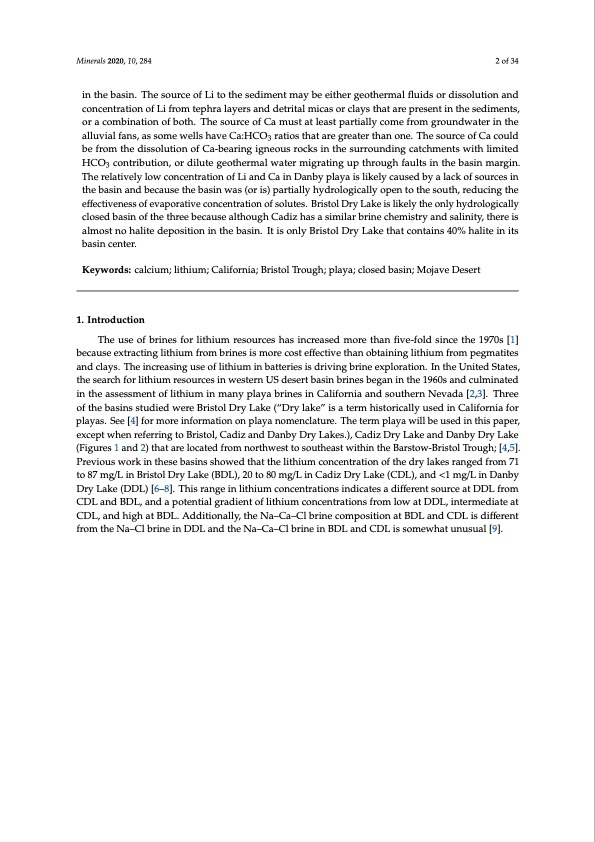
PDF Publication Title:
Text from PDF Page: 002
Minerals 2020, 10, 284 2 of 34 in the basin. The source of Li to the sediment may be either geothermal fluids or dissolution and concentration of Li from tephra layers and detrital micas or clays that are present in the sediments, or a combination of both. The source of Ca must at least partially come from groundwater in the alluvial fans, as some wells have Ca:HCO3 ratios that are greater than one. The source of Ca could be from the dissolution of Ca-bearing igneous rocks in the surrounding catchments with limited HCO3 contribution, or dilute geothermal water migrating up through faults in the basin margin. The relatively low concentration of Li and Ca in Danby playa is likely caused by a lack of sources in the basin and because the basin was (or is) partially hydrologically open to the south, reducing the effectiveness of evaporative concentration of solutes. Bristol Dry Lake is likely the only hydrologically closed basin of the three because although Cadiz has a similar brine chemistry and salinity, there is almost no halite deposition in the basin. It is only Bristol Dry Lake that contains 40% halite in its basin center. Keywords: calcium; lithium; California; Bristol Trough; playa; closed basin; Mojave Desert 1. Introduction The use of brines for lithium resources has increased more than five-fold since the 1970s [1] because extracting lithium from brines is more cost effective than obtaining lithium from pegmatites and clays. The increasing use of lithium in batteries is driving brine exploration. In the United States, the search for lithium resources in western US desert basin brines began in the 1960s and culminated in the assessment of lithium in many playa brines in California and southern Nevada [2,3]. Three of the basins studied were Bristol Dry Lake (“Dry lake” is a term historically used in California for playas. See [4] for more information on playa nomenclature. The term playa will be used in this paper, except when referring to Bristol, Cadiz and Danby Dry Lakes.), Cadiz Dry Lake and Danby Dry Lake (Figures 1 and 2) that are located from northwest to southeast within the Barstow-Bristol Trough; [4,5]. Previous work in these basins showed that the lithium concentration of the dry lakes ranged from 71 to 87 mg/L in Bristol Dry Lake (BDL), 20 to 80 mg/L in Cadiz Dry Lake (CDL), and <1 mg/L in Danby Dry Lake (DDL) [6–8]. This range in lithium concentrations indicates a different source at DDL from CDL and BDL, and a potential gradient of lithium concentrations from low at DDL, intermediate at CDL, and high at BDL. Additionally, the Na–Ca–Cl brine composition at BDL and CDL is different from the Na–Cl brine in DDL and the Na–Ca–Cl brine in BDL and CDL is somewhat unusual [9].PDF Image | Bristol Dry Lake Brine Compared to Brines from Cadiz

PDF Search Title:
Bristol Dry Lake Brine Compared to Brines from CadizOriginal File Name Searched:
minerals-10-00284-v2.pdfDIY PDF Search: Google It | Yahoo | Bing
Product and Development Focus for Infinity Turbine
ORC Waste Heat Turbine and ORC System Build Plans: All turbine plans are $10,000 each. This allows you to build a system and then consider licensing for production after you have completed and tested a unit.Redox Flow Battery Technology: With the advent of the new USA tax credits for producing and selling batteries ($35/kW) we are focussing on a simple flow battery using shipping containers as the modular electrolyte storage units with tax credits up to $140,000 per system. Our main focus is on the salt battery. This battery can be used for both thermal and electrical storage applications. We call it the Cogeneration Battery or Cogen Battery. One project is converting salt (brine) based water conditioners to simultaneously produce power. In addition, there are many opportunities to extract Lithium from brine (salt lakes, groundwater, and producer water).Salt water or brine are huge sources for lithium. Most of the worlds lithium is acquired from a brine source. It's even in seawater in a low concentration. Brine is also a byproduct of huge powerplants, which can now use that as an electrolyte and a huge flow battery (which allows storage at the source).We welcome any business and equipment inquiries, as well as licensing our turbines for manufacturing.| CONTACT TEL: 608-238-6001 Email: greg@infinityturbine.com | RSS | AMP |